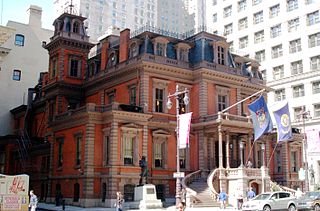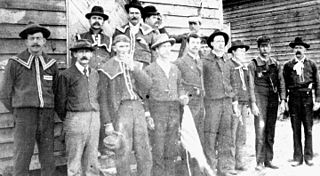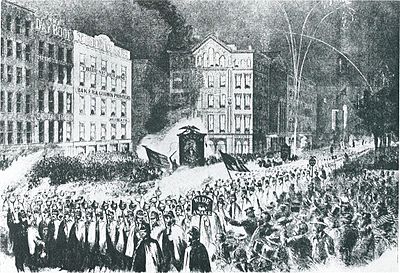
The 1860 United States presidential election was the 19th quadrennial presidential election, held on Tuesday, November 6, 1860. In a four-way contest, the Republican Party ticket of Abraham Lincoln and Hannibal Hamlin won a national popular plurality, a popular majority in the North where states already had abolished slavery, and a national electoral majority comprising only Northern electoral votes. Lincoln's election thus served as the main catalyst of the states that would become the Confederacy seceding from the Union. This marked the first time that a Republican was elected president. It was also the first presidential election in which both major party candidates were registered in the same home state; the others have been in 1904, 1920, 1940, 1944, and 2016.

The Battle of Fort Sumter was the bombardment of Fort Sumter near Charleston, South Carolina by the South Carolina militia. It ended with its surrender by the United States Army, beginning the American Civil War.

The Lincoln–Douglas debates were a series of seven debates between Abraham Lincoln, the Republican Party candidate for the United States Senate from Illinois, and incumbent Senator Stephen Douglas, the Democratic Party candidate. Until the Seventeenth Amendment to the United States Constitution, which provides that senators shall be elected by the people of their states, was ratified in 1913, senators were elected by their respective state legislatures, so Lincoln and Douglas were trying to win the votes of the Illinois General Assembly for their respective parties.

Francis Preston Blair Jr. was a United States Senator, a United States Congressman and a Union Major General during the Civil War. He represented Missouri in both the House of Representatives and the Senate, and was active in preventing the State of Missouri from being absorbed into the Confederacy at the beginning of the Civil War.

The 1860 Republican National Convention was a presidential nominating convention that met May 16–18 in Chicago, Illinois. It was held to nominate the Republican Party's candidates for president and vice president in the 1860 election. The convention selected former representative Abraham Lincoln of Illinois for president and Senator Hannibal Hamlin of Maine for vice president.

The Young Republican National Federation, commonly referred to as the Young Republicans or YRNF, is a 527 organization for members of the Republican Party of the United States between the ages of 18 and 40. It has both a national organization and chapters in individual states.
In American history, the Fire-Eaters were a group of pro-slavery Democrats in the antebellum South who urged the separation of Southern states into a new nation, which became the Confederate States of America. The dean of the group was Robert Rhett of South Carolina. Some sought to revive America's participation in the Atlantic slave trade, which had been illegal since 1808.

The Union Leagues were quasi-secretive men's clubs established separately, starting in 1862, and continuing throughout the Civil War (1861–1865). The oldest Union League of America council member, an organization originally called "The League of Union Men", was formed in June 1862 in Pekin, Illinois. Four months later, on November 22, 1862, the Union League of Philadelphia, the first of the elite eastern Leagues and the second oldest ULA council member, was established.

The House Divided Speech was an address given by senatorial candidate and future president of the United States Abraham Lincoln, on June 16, 1858, at what was then the Illinois State Capitol in Springfield, after he had accepted the Illinois Republican Party's nomination as that state's US senator. The nomination of Lincoln was the final item of business at the convention, which then broke for dinner, meeting again at 8 pm. "The evening session was mainly devoted to speeches", but the only speaker was Lincoln, whose address closed the convention, save for resolutions of thanks to the city of Springfield and others. His address was immediately published in full by newspapers, as a pamphlet, and in the published proceedings of the convention. It was the launching point of his unsuccessful campaign for the senatorial seat held by Stephen A. Douglas; the campaign would climax with the Lincoln–Douglas debates. When Lincoln collected and published his debates with Douglas as part of his 1860 presidential campaign, he prefixed them with relevant prior speeches. The "House Divided" speech opens the volume.

In the 19th century, a number of new methods for conducting American election campaigns developed in the United States. For the most part the techniques were original, not copied from Europe or anywhere else. The campaigns were also changed by a general enlargement of the voting franchise—the states began removing or reducing property and tax qualifications for suffrage and by the early 19th century the great majority of free adult white males could vote. During the Reconstruction Era, Republicans in Congress used the military to create a biracial electorate, but when the troops were removed in 1877, blacks steadily lost political power in the increasingly one-party Southern United States. After 1890 blacks generally lost the vote in the South.

The Slave Power, or Slavocracy, referred to the perceived political power held by American slaveowners in the federal government of the United States during the Antebellum period. Antislavery campaigners charged that this small group of wealthy slaveholders had seized political control of their states and were trying to take over the federal government illegitimately to expand and protect slavery. The claim was later used by the Republican Party that formed in 1854–55 to oppose the expansion of slavery.

The Red Shirts or Redshirts of the Southern United States were white supremacist paramilitary terrorist groups that were active in the late 19th century in the last years of, and after the end of, the Reconstruction era of the United States. Red Shirt groups originated in Mississippi in 1875, when anti-Reconstruction private terror units adopted red shirts to make themselves more visible and threatening to Southern Republicans, both whites and freedmen. Similar groups in the Carolinas also adopted red shirts.

The state of Iowa played a significant role during the American Civil War in providing food, supplies, troops and officers for the Union army.

John McEnery was a Louisiana Democratic politician and lawyer who was considered by Democrats to be the winner of the highly contested 1872 election for Governor of Louisiana. After extended controversy over election results, the Republican candidate William Pitt Kellogg was certified. McEnery, who had been an officer in the Confederate States Army during the American Civil War, was not allowed to take office following a weighing in by the federal government and local Republicans loyal to President Ulysses S. Grant.

The Know Nothings were a nativist political movement in the United States in the 1850s, officially known as the Native American Party before 1855, and afterwards simply the American Party. Members of the movement were required to say "I know nothing" whenever they were asked about its specifics by outsiders, providing the group with its colloquial name.
The U.S. state of Louisiana declared that it had seceded from the United States on January 26, 1861. It then announced that it had joined the Confederate States (C.S.); Louisiana was the sixth slave state to declare that it had seceded from the U.S. and joined the C.S.

The Minutemen was a secessionist paramilitary organization in St. Louis, Missouri in the early months of 1861. Many members joined the 2nd Regiment of the Missouri Volunteer Militia, and after May 10, 1861 the Missouri State Guard or the Confederate States Army.

The 1860 United States presidential election in Virginia took place on November 6, 1860, as part of the 1860 United States presidential election. Voters chose 15 representatives, or electors to the Electoral College, who voted for president and vice president.

The United States Zouave Cadets was a short-lived zouave unit of the Illinois militia that has been credited as the force behind the surge in popularity of zouave infantry in the United States and Confederate States in the mid-19th century. The United States Zouave Cadets were formed by Elmer Ellsworth in 1859 from the National Guard Cadets of Chicago, established three years earlier. The unit's 1860 tour of the eastern United States popularized the distinctive zouave appearance and customs, directly and indirectly inspiring the formation of dozens of similar units on the eve of the American Civil War.
This article documents the political career of Abraham Lincoln from the end of his term in the United States House of Representatives in March 1849 to the beginning of his first term as President of the United States in March 1861.



















